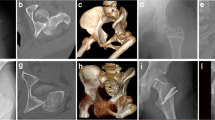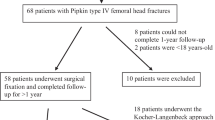Abstract
Background and purpose
The optimal surgical approach for the treatment of femoral head fracture remains controversial. We retrospectively reviewed patients with Pipkin type I and II femoral head fractures managed surgically through posterior Kocher–Langenbeck approach and Ganz trochanteric flip approach aiming to define the best approach with the least morbidity.
Patients and methods
Between May 1995 and November 2010, 23 patients (14 men and 9 women) with an average age of 39.1 years (range 27–62) were treated by open reduction and internal fixation of femoral head fractures (5, Pipkin type I; and 18, type II) through Kocher–Langenbeck approach in 11 patients and trochanteric flip (digastric) osteotomy in 12. The two approaches were compared regarding operative time, difficulty of reduction and fixation, amount of blood loss, occurrence of femoral head osteonecrosis or heterotopic ossification and the final functional outcome. The scale of Brooker was used to document heterotopic ossification. The modified Merle d’Aubigne and Postel as well as Thompson and Epstein scores were used for final evaluation.
Results
Trochanteric flip approach was associated with less operative time, less blood loss and improved visualization facilitating direct screw fixation compared with Kocher–Langenbeck approach. Non-union of the trochanteric osteotomy developed in one patient. Heterotopic ossification was seen more in trochanteric flip-approached cases. Avascular necrosis of the femoral head occurred in one patient (8.1 %) of trochanteric flip-approached group and two (18.1 %) of posterior approach group. All patients were followed up for an average of 31 months (range 24–84). Except for one patient, the final outcomes were equal in the two groups.
Conclusions
Despite the limited number of patients, we can conclude that good final outcome does not necessarily follow a specific approach.


Similar content being viewed by others
References
Epstein HC, Wiss DA, Cozen L (1985) Posterior fracture-dislocation of the hip with fractures of the femoral head. Clin Orthop Relat Res 201:9–17
Hougaard K, Thomsen PB (1988) Traumatic posterior fracture-dislocation of the hip with fracture of the femoral head or neck, or both. J Bone Jt Surg (Am) 70:233–239
Sahin V, Karakas ES, Aksu S, Atlihan D, Turk CY, Halici M (2003) Traumatic dislocation and fracture-dislocation of the hip: a long-term follow-up study. J Trauma 54:520–529
Pipkin G (1957) Treatment of grade IV fracture-dislocation of the hip. J Bone Jt Surg (Am) 39:1027–1042
Birkett J (1869) Description of a dislocation of the head of the femur: with remarks. Med Chir Trains 52:133
Dreinhofer KE, Schwarzkopf SR, Haas NP, Tscherne H (1996) Femur head dislocation fractures. long-term outcome of conservative and surgical therapy. Unfallchirurg 99(6):400–409
Mowery C, Gershuni DH (1986) Fracture dislocation of the femoral head treated by open reduction and internal fixation. J Trauma 26(11):1041–1044
Schonweiss T, Wagner S, Mayr E, Ruter A (1999) Late results after fracture of the femoral head. Unfalluchirurg 102(10):776–783
Dowd GSF, Johnson R (1979) Successful conservative treatment of a fracture dislocation of the femoral head-a case report. J Bone Jt Surg (Am) 16-A:1244–1246
Butler JE (1981) Pipkin type-II fractures of the femoral head. J Bone Jt Surg (Am) 63:1292–1296
Lange RH, Engber WD, Clancy WG (1986) Expanding application for the herbert scaphoid screw. Orthopedics 9:1393–1397
Swiontkowski MF, Thorpe M, Seiler JG, Hansen ST (1992) Operative management of displaced femoral head fractures: case matched comparison of anterior vesus posterior approaches for Pipkin I and Pipkin II fractures. J Orthop Trauma 6:437–442
Mrchetti ME, Steinberg GG, Goumas JM (1996) Intermediate term experience of Pipkin fracture-dislocations of the hip. J Orthop Trauma 10:455–461
Ganz R, Gill TJ, Gautier E, Ganz K, Krugel N, Berlemann U (2001) Surgical dislocation of the adult hip: a technique with full acess to the femoral head and acetabulum without the risk of avascular necrosis. J Bone Jt Surg (Br) 81:1119–1124
Henle P, Kloen P, Siebenrock KA (2007) Femoral head injuries: which treatment strategy can be recommended? Injury 38:478–488
Brooker AF, Browerman JW, Robinson RA, Riley LH Jr (1973) Ectopic ossification following total hip replacement: incidence and a method of classification. J Bone Jt Surg (Am) 55:1629–1632
Matta JM, Mehne DK, Roffi R (1986) Fractures of the acetabulum. early results of a prospective study. Clin Orthop 205:241–250
Thompson VP, Epstein HC (1951) Traumatic dislocation of the hip: a survey of two hunderd and four cases covering a period of twenty-one years. J Bone Jt Surg (Am) 33:746–778
Stannard JP, Harris HW, Volgas DA, Alonso JE (2000) Functional outcome of patients with femoral head fractures associated with hip dislocation. Clin Orthop Relat Res 377:44–56
Droll KP, Broekhuyse H, O’Brien P (2007) Fracture of the femoral head. J Am Acad Orthop Surg 15:716–727
McMurtry IA, Quaile A (2001) Closed reduction of the traumatically dislocated hip: a new technique. Injury 32(2):162–164
Chen ZW, Zahi WL, Ding ZQ, Lian KJ, Kang LQ, Guo LX, Liu H, Lin B (2011) Operative versus nonoperative management of Pipkin type II fractures associated with posterior hip dislocation. Orthopedics 34(5):350. doi:10.3928/01477447-20110317-09
Stockenhuber N, Schweighofer F, Seibert FJ (1994) Diagnosis, therapy and prognosis of Pipkin fractures (femur head dislocation fractures). Chirurg 65:976–982
Vermeiren JA, van Hoye M (1991) Three cases of femoral head fracture in a single care accident. J Trauma 31:579–581
Ozcan M, Copuroglu C, Saridogan K (2011) Fractures of the femoral head: what are the reasons for poor outcome? Uls Travma Acil Cerrahi Derg 17(1):51–56
Kloen P, Siebenrock KA, Raaymaker ELFB, Marti RK, Ganz R (2002) Femoral head fractures revisited. Eur J Trauma 4:221–223
Dxion SM, Reddy RP, Williams D, Fern D, Norton (2010) Non-union following bilateral simultaneous ganz trochanteric osteotomy. Orthop Rev (Pavia) 2(1):e1. doi:10.4081/or.2010.e1
Bastian JD, Wolf AT, wyss TF, Notzli HP (2009) Stepped osteotomy of the trochanter for stable, anatomic fixation. Clin Orthop Relat Res 467:732–738
Gautier E, Ganz K, Krugel N, Gill T, Ganz R (2000) Anatomy of the medial femoral circumflex artery and its surgical implications. J Bone Jt Surg (Br) 82:679–683
Khan A, Yates P, Lovering A, Bannister GC, Spencer RF (2007) The effect of surgical approach on blood flow to the femoral head during resurfacing. J Bone Jt Surg (Br) 89:21–25
Moore KD, Gross K, Anglen JO (1998) Indomethacin versus radiation therapy for prophylaxis against heterotopic ossification in acetabular fractures: a randomised, prospective study. J Bone Jt Surg (Br) 80(2):259–263
Burd TA, Hughes MS, Anglen JO (2003) Heterotopic ossification prophylaxis with indomethacin increases the risk of long-bone non-union. J Bone Jt Surg (Br) 85(5):700–705
Author information
Authors and Affiliations
Corresponding author
Rights and permissions
About this article
Cite this article
Mostafa, M.F., El-Adl, W. & El-Sayed, M.AE. Operative treatment of displaced Pipkin type I and II femoral head fractures. Arch Orthop Trauma Surg 134, 637–644 (2014). https://doi.org/10.1007/s00402-014-1960-5
Received:
Published:
Issue Date:
DOI: https://doi.org/10.1007/s00402-014-1960-5




